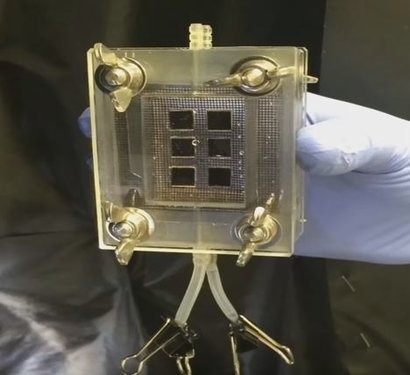
Renewable hydrogen developer HyperSolar, Inc. announced a milestone achievement in completing a newly designed hydrogen generation prototype that can be scaled to commercial size for the production of renewable hydrogen at or near the point of distribution. The device uses breakthrough technology to produce renewable hydrogen using sunlight and any source of water.
HyperSolar’s research is focused on developing a completely renewable, low-cost and submersible hydrogen production particle that can split water molecules under the sun, emulating the core functions of photosynthesis. Each particle is a complete hydrogen generator that contains a novel high voltage solar cell bonded to chemical catalysts by a proprietary encapsulation coating.
By optimising the science of water electrolysis at the nano-level, the company’s low cost nanoparticles mimic photosynthesis to efficiently use sunlight to separate hydrogen from water, to produce environmentally friendly renewable hydrogen. Using its low cost method to produce renewable hydrogen, the company intends to enable a world of distributed hydrogen production for renewable electricity and hydrogen fuel cell vehicles.
“We are pleased to follow through on our stated goal of producing a working prototype that we believe represents the potential for the most viable and completely renewable hydrogen technology” said Tim Young, CEO of HyperSolar. “One of our most significant visual demonstrations to date, this working prototype showcases the technological successes that HyperSolar and our scientific partners, the University of Iowa and the University of California, Santa Barbara have achieved over the past year. As our focus turns to scalability, we expect that this new device design will provide a blueprint for commercial viability to meet market demand within consumer (such as hydrogen fuel cell vehicle) and industrial applications.”
The complete working prototype device and the accompanying video showcases renewable hydrogen produced directly using polluted water from the Salton Sea in Imperial County California. When exposed to sunlight, water molecules are split into hydrogen in one chamber and oxygen in the other, a process very important to the success of the technology due to the explosive potency of the mixture. Additionally, the waste in the water is actually broken down, therefore cleaning up the contaminated Salton Sea water used in the process.
The patent-pending device design contains HyperSolar’s proprietary hydrogen production particle which consists of a high voltage solar cell encapsulated in a protective catalyst coating, integrated into a membrane separator. The protective coating has been demonstrated to allow hydrogen production to run for hundreds of hours in very corrosive water, without damage. To fully demonstrate fuel cell capabilities, the produced hydrogen is connected to a fuel cell that converts hydrogen into usable electricity, ultimately facilitating electrical power to illuminate the two light bulbs.
The prototype device was developed partly with the assistance of new hires and partly through existing sponsored research agreements with leading universities and individuals. The company is confident that, once scaled, the device can be made to meet real world market demand.
For additional information:

